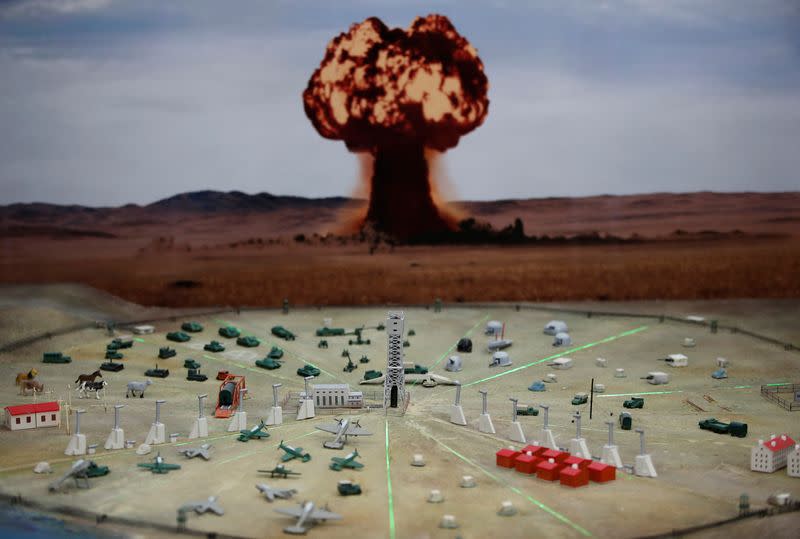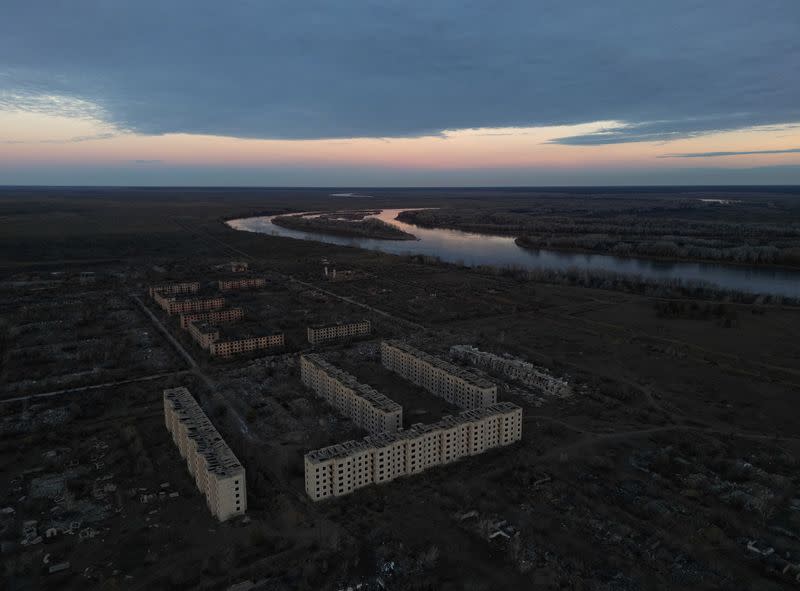Russia's nuclear arsenal: how big is it, and who controls it?
- Oops!Something went wrong.Please try again later.
By Guy Faulconbridge
MOSCOW (Reuters) -President Vladimir Putin warned the West on Wednesday that Russia was technically ready for nuclear war and that if the United States sent troops to Ukraine the move would be considered a significant escalation of the war.
Here are key facts about Russia's nuclear arsenal:
HOW MANY NUCLEAR WEAPONS DOES RUSSIA HAVE?
Russia, which inherited the Soviet Union's nuclear weapons, has the world's biggest store of nuclear warheads.
Putin controls about 5,580 nuclear warheads, according to the Federation of American Scientists (FAS).
Of those about 1,200 are retired but largely intact and around 4,380 are stockpiled for use by long-range strategic launchers and shorter-range tactical nuclear forces, according to the FAS.
Of the stockpiled warheads, 1,710 strategic warheads are deployed: about 870 on land-based ballistic missiles, about 640 on submarine-launched ballistic missiles, and possibly 200 at heavy bomber bases, FAS said.
Such numbers mean that both Moscow could destroy the world many times over.
During the Cold War, the Soviet Union had a peak of around 40,000 nuclear warheads, while the U.S. peak was around 30,000.
UNDER WHAT CIRCUMSTANCES WOULD THEY BE USED?
Russia's published 2020 nuclear doctrine sets out the conditions under which a Russian president would consider using a nuclear weapon: broadly as a response to an attack using nuclear or other weapons of mass destruction, or to the use of conventional weapons against Russia "when the very existence of the state is put under threat."
WILL RUSSIA GET MORE NUKES?
The United States said in its 2022 Nuclear Posture Review that Russia and China were expanding and modernising their nuclear forces, and that Washington would pursue an approach based on arms control to head off costly arms races.
"While Russia’s nuclear statements and threatening rhetoric are of great concern, Russia’s nuclear arsenal and operations have changed little since our 2023 estimates beyond the ongoing modernization," the FAS said in its 2024 analysis of Russian forces.
"In the future, however, the number of warheads assigned to Russian strategic forces may increase as single-warhead missiles are replaced with missiles equipped with multiple warheads," FAS said.
WILL RUSSIA CARRY OUT A NUCLEAR TEST?
Putin has said Russia would consider testing a nuclear weapon if the United States did.
Last year, he signed a law withdrawing Russia's ratification of the Comprehensive Nuclear Test Ban Treaty (CTBT).
Post-Soviet Russia has not carried out a nuclear test.
Since the Soviet Union collapsed in 1991, only a few countries have tested nuclear weapons, according to the Arms Control Association: the United States last tested in 1992, China and France in 1996, India and Pakistan in 1998, and North Korea in 2017.
The Soviet Union last tested in 1990.
The Comprehensive Nuclear-Test Ban Treaty was signed by Russia in 1996 and ratified in 2000. The United States signed the treaty in 1996 but has not yet ratified it.
WHO WOULD GIVE THE RUSSIAN LAUNCH ORDER?
The Russian president is the ultimate decision maker on the use of Russian nuclear weapons.
The so-called nuclear briefcase, or "Cheget" (named after Mount Cheget in the Caucasus Mountains), is with the president at all times. The Russian defence minister, currently Sergei Shoigu, and the chief of the general staff, currently Valery Gerasimov, are also thought to have such briefcases.
Essentially, the briefcase is a communication tool that links the president to his military top brass and thence to rocket forces via the highly secret "Kazbek" electronic command-and-control network. Kazbek supports another system known as "Kavkaz".
Footage shown by Russia's Zvezda television channel in 2019 showed what it said was one of the briefcases with an array of buttons. In a section called "command" there are two buttons: a white "launch" button and a red "cancel" button. The briefcase is activated by a special flashcard, according to Zvezda.
If Russia thought it faced a strategic nuclear attack, the president, via the briefcases, would send a direct launch order to general staff command and reserve command units that hold nuclear codes. Such orders cascade swiftly down different communications systems to strategic rocket force units, which then fire at the United States and Europe.
If a nuclear attack were confirmed, Putin could activate the so-called "Dead Hand" or "Perimetr" system of last resort: essentially computers would decide doomsday. A control rocket would order nuclear strikes from across Russia's vast armoury.
(Reporting by Guy Faulconbridge; Editing by Kevin Liffey and Andrew Heavens)

